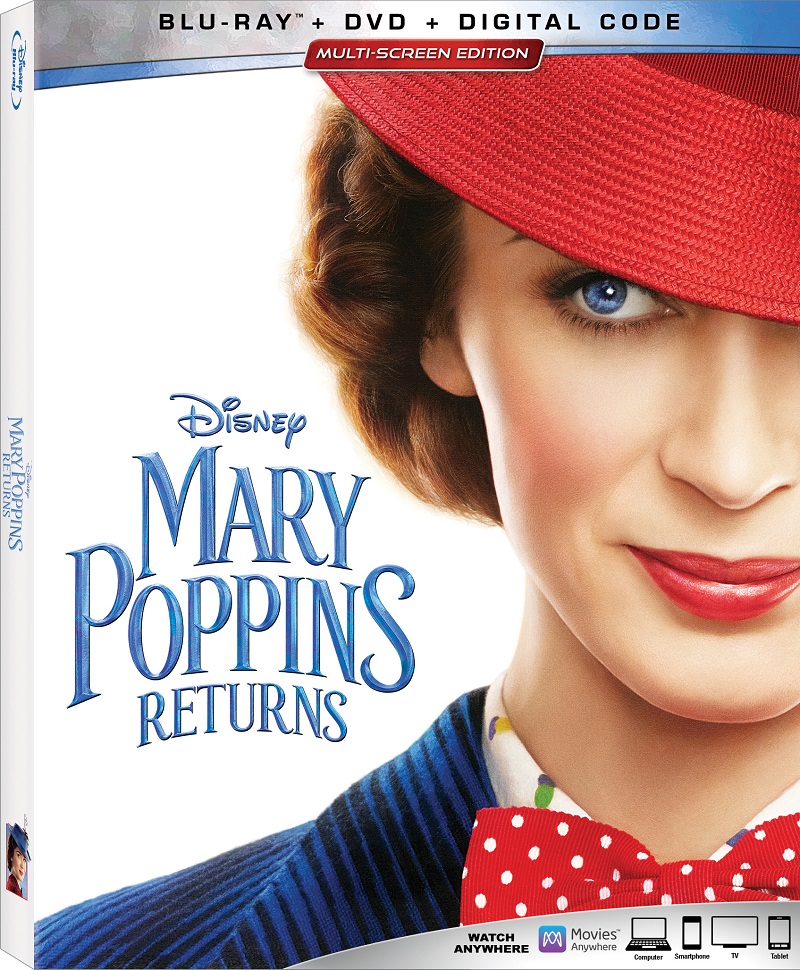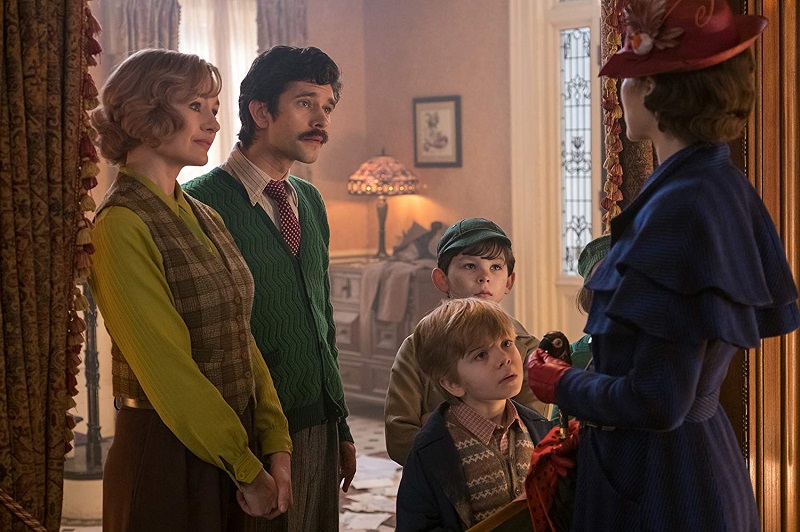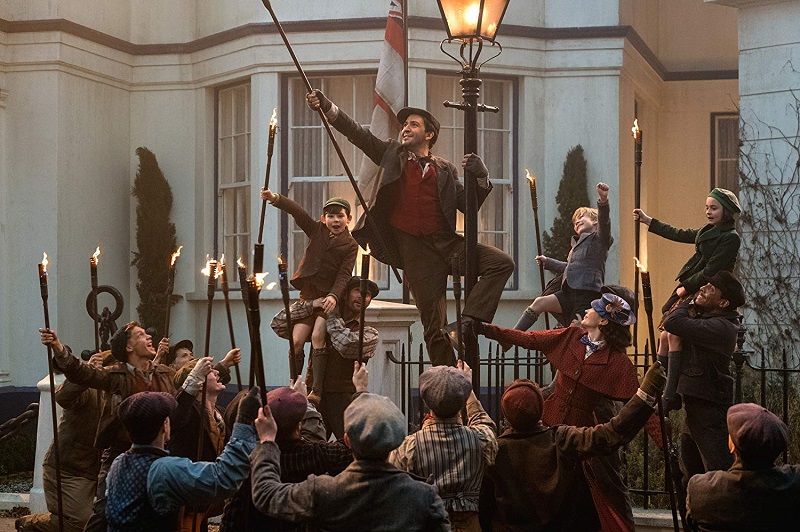When it was announced that Disney was going to pursue a sequel to their iconic Mary Poppins, many in the film press business wondered, “Why?!” First of all, author P.L. Travers had numerous tales about the nanny with powers that go beyond helping to rear good natured children—so, why not?! Secondly, the studio had cast Emily Blunt as the titular character and if anyone could step into those shoes and carry that fabled umbrella that Julie Andrews carried it was her fellow countrywoman, Blunt. Now, this film journalist was getting excited.

Mary Poppins Returns landed in theaters over the holidays and triumphed in every sense of the word—from box office to critical response. Now that the long gestating musical sequel has arrived on DVD, Blu-Ray and digital download formats, it is a priceless opportunity to revisit a modern classic and if you happened to have missed the experience of witnessing it in theaters, it is a tale that works brilliantly on the home video landscape.
We should add before we get into the nitty-gritty of our Mary Poppins Returns Blu-Ray review, another reason for excitement about this sequel arrived in the form of Disney tapping movie musical director extraordinaire Rob Marshall (Chicago, Into the Woods). Then, another firework went off with another casting choice, Tony Award winning Hamilton creator Lin Manuel Miranda was added to the cast and anticipation could not have been higher.
So, with all that going for the sequel to Mary Poppins, how was it? As an astute audience knows (which is what film fans have become over these last few decades), how a film looks on paper and what it truly accomplishes once viewed can be polar opposites. The Academy doesn’t just pass out Oscar nods to just anyone and it should speak volumes that this sequel that no one thought they needed scored four nominations—Best Original Song, Best Original Score, Best Costume Design and Best Production Design.
As was the case when Mary Poppins arrived on screens in 1964, the Banks family is in disarray and in dire need of some familial help—which of course arrived in the form of Andrews’ titular nanny. Things are slightly different, but the gaping hole that Michael Banks (Ben Whishaw) has since his wife and the mother of his children passed away has been slightly filled by his sister Jane Banks (Emily Mortimer). His kids are young, but not naïve and keenly know that their father is not the same since their mother died. It’s great to have Aunt Jane around, but things are falling through the cracks, both literally and (emotionally) figuratively.
That first Mary Poppins Returns trailer showed us exactly how help was coming and in what form. Of course, it is exactly as the moniker of the film states. Jack (Miranda) and one of the Banks children are out with a kite (that might be familiar to anyone who adores the first film) and low and behold, look who comes cascading down from the sky? Blunt’s Mary Poppins makes quite an entrance and when she saunters into the Banks home it is with pure Poppins panache and power and for the first time in a while, there is a sense of optimism that has come over the homestead and rightfully so.
From the moment Blunt appears as Poppins, it is not only like she has taken over the role from Andrews, but it is like she went to the Julie Andrews school of character development. It is uncanny. Blunt clearly makes the role her own, but there is enough of a similarity to what Andrews so iconically delivered that longtime fans and new ones will be equally as enthralled.
Times are challenging for the Banks, and it is not solely due to the tragic absence of the maternal influence. This is depression era London and work is hard to come by for everyone. As soon as Poppins arrives, we (as an audience) and the Banks clan up on screen are reminded of the key to her magic. It wasn’t necessarily the literal “magic” she utilizes, it is how she makes challenging situations and learning opportunities enjoyable—through song, lightheartedness and a (ironically) grounded approach to dealing with children.
She teams up with her old friend Jack (who like Dick Van Dyke’s character from the original is a salt of the earth laborer who is like a yin to Poppins’ yang) and we are off on a journey that is filled with joy, musical numbers that rival the original’s and above all else—a cinematic command that uncannily mirrors the original, something utterly difficult to achieve that Marshall and his team of storytellers have masterfully accomplished.

There are some righteous new additions to this world, most notably Mary’s wild cousin Topsy (Meryl Streep), Jack’s toe-tapping band of leeries, bank executives (who hold the Banks’ family future in their hands) William Weatherall Wilkins (Colin Firth) and Mr. Dawes Jr. (Van Dyke!). They all contribute to bringing a light into a Banks household that has been more grey than colorful of late.
Don’t miss my theatrical Mary Poppins Returns review for more details on the film itself.
The highlight for this writer of the bonus features for Mary Poppins Returns must be Back to Cherry Tree Lane: Dick Van Dyke Returns. The icon is back in the series, but in a different role, and once you see the scene that features him prominently in it, try to not smile broadly while experiencing it and reverberating from it for the remainder of the film. The featurette finds the cast and crew waxing poetic about everything from the sheer talent of Van Dyke, to even simply having him on the set and how that impacted the production as a whole—what with having an original member of the legendary ensemble part of this this one.
Next up on the must-see featurette list is Seeing Things from a Different Point of View: The Musical Numbers of Mary Poppins Returns which breaks down the making-of several of the film’s most triumphant musical numbers. Trip A Little Light Fantastic is one of my personal favorites of the new tracks in the film. The featurette finds the cast and crew putting the song’s importance to the overall story arc of the film in perfect perspective and how the choreography for the number was a direct salute to the original flick. Hearing them talk about the new song and how it has that “feel” of the original movie, one can just sense the “pinch themselves” vibe from all involved that they were even able to experience such a professional and personal treat.
The Royal Douton Music Hall/A Cover Is Not the Book featurette, for this appreciator of the original’s use of animation and live action, is astounding. Hearing all involved and their nerves, excitement and challenges of melding animation and live action for the new track spurred an unquenchable desire to return to that part of the film and watch the sequence again after gaining priceless insight into how it was achieved.
Turning Turtle and Can You Imagine That? round out the making-of featurettes on the “bigger” song and dance numbers for Mary Poppins Returns and the former gives us a surprising insight into the production design (which was nominated for an Oscar) for the Topsy Turvy sequence and gives us a stellar look at how the entire thing came together. The latter featurette gives an uncanny look at how the bathtub-commencing scene became a CGI-laden musical masterpiece.

After witnessing the film a first time on home video, might I suggest turning on the Song-Along Mode and joining in on the musical mastery with lyrics that appear on the screen as the cast give us their musical movie magic.
Usually a musical doesn’t produce the best bloopers, but Practically Perfect Bloopers could not have been a better title for this almost two-minute look at the humorous moments from the shoot that didn’t quite go as planned!
Also of interest is the inclusion of a deleted song—The Anthropomorphic Zoo. The track would have appeared where The Royal Douton Music Hall sits in the film and is an incomplete scene-as it was never included but hearing songwriter Marc Shaiman sing it with rough sketches is a fascinating look at how filmmakers make tough decisions while making a movie and how they all happen for a reason.
The making-of featurette that we all want to see, especially for a flick like this, comes in the form of The Practically Perfect Making of Mary Poppins Returns. The almost 24-minute, four-part, feature takes the making-of the movie from a quarter of perfect angles.
Introduction features the cast and crew extoling the joys of the original film and the tough road that they traversed in bringing the world a sequel. Underneath the Lovely London Sky takes us behind the movie magic of recreating the original set from the first film (for congruency’s sake…after all, Mary Poppins fans are a serious bunch when it comes to their adoration of that original). Also featured is a true appreciation that all felt being in awe at the opportunity that they all had being a part of something that was and is so iconic.
Can You Imagine That? puts the spotlight firmly on the ringmaster for this movie musical circus, director Marshall. The featurette looks at the filmmaker’s team that he put together, and how he sought to not reinvent the wheel in terms of creating a Mary Poppins world, while still forging something unique with their take and the biggest insight is hearing Marshall talk about filming the actual moment we meet Mary for the first time in this film.
Nowhere To Go But Up is a delightful look at the contribution of Angela Lansbury Van Dyke and how their sheer presence in the movie elevated the experience in every conceivable manner.
Film Grade: B
Bonus Features: A

